AccessINCLUDES: Accessibility and Disability in the INCLUDES National Network Conference (2019)
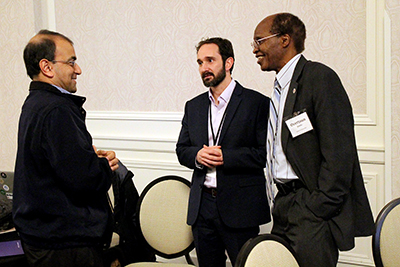
Proceedings of an AccessINCLUDES Conference
February 20-22, 2019
Seattle, WA
AccessINCLUDES, funded by the National Science Foundation (NSF), links to the NSF INCLUDES (Inclusion across the Nation of Communities of Learners of Underrepresented Discoverers in Engineering and Science) Network by sharing knowledge and results from other NSF disability-focused projects and their network organizations in order to make the INCLUDES Network better prepared to
- address disability-related issues in their research (e.g., design interventions to be accessible; recruit, support, and report outcomes for participants with disabilities);
- make meetings, trainings, courses, and other project activities welcoming and accessible to individuals with disabilities;
- design project resources and products to be accessible to individuals with disabilities; and
- develop durable, new collaborations between multiple stakeholders and organizations that lead to future innovative projects and resources that are inclusive of individuals with disabilities.
AccessINCLUDES activities include creating a community of practice and hosting multiple webinars and online trainings in pursuit of these initiatives. This event aimed to bring together a community to share knowledge on a plethora of disability, accessibility, and universal design concepts and find community in the INCLUDES Network.
Agenda
Wednesday, February 20
7:00–9:00 pm
No-host networking reception
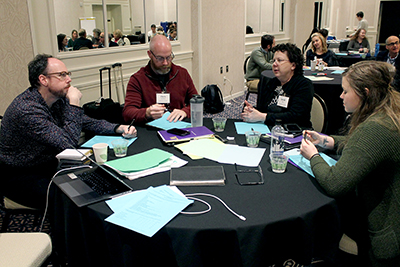
Thursday, February 21
8:00–9:00 am
Breakfast and networking
9:00–10:55 am
Welcome and introductions
Overview of AccessINCLUDES goal, objectives, and activities
Sheryl Burgstahler, University of Washington (UW)
- Universal/inclusive design and other design approaches that lead to inclusive research and practice.
- Video – Equal Access: Universal Design of an Academic Department
10:55–11:15 am
Overview of NSF INCLUDES and the Coordination Hub
Timothy Podkul, SRI International
11:15–11:30 am
Discussion
11:45 am–12:30 pm
Panel Discussion: Experiences of People with Disabilities in STEM Fields
Panelists: Nils Hakansson (Wichita State University), Raja Kushalnagar (Gallaudet University), Marta Larson (Michigan After-School Partnership), Vinod Namboodiri (Wichita State University)
Moderator: Brianna Blaser, UW
12:30–1:15 pm
Lunch and discussion
What can we do to increase the representation of people with disabilities in INCLUDES projects? Why haven’t more INCLUDES projects considered disability?
1:30–2 pm
Report out from lunch and discussion
1:30–3:30 pm
Short presentations: Disability & Accessibility in STEM Fields
- Working Across Disciplines to Improve Digital Accessibility – Jonathan Lazar, University of Maryland, College Park
- Equity by Design – Joan Freese, Twin Cities PBS
- Embedding Neurodivergent Software Design in a CS Course – John Russo, Landmark College
- STEM education and career exposure software for deaf and reading-challenged students – Greg Monty, North Carolina A&T State University
- Digital INaccessibility: Why Haven’t We Figured This Out Yet? – Nora Ryan, Iowa State University
- Strengthening the National STEM Workforce through Accessible and Inclusive Strategic Alignment – Chris Atchison, University of Cincinnati
3:45–4:15 pm
Large group discussion of today’s topics
What resources would be useful to the INCLUDES community in helping them (1) better address disability-related issues, (2) make activities more welcoming and accessible, and (3) develop collaborations that lead to future innovative projects and resources that are inclusive of individuals with disabilities?
4:15–4:30 pm
Evaluation of today’s activities and recommendations for tomorrow
5:30–7 pm
Dinner and discussion
What are barriers and possible solutions individuals with disabilities might encounter within INCLUDES or other STEM research, instruction, and projects?
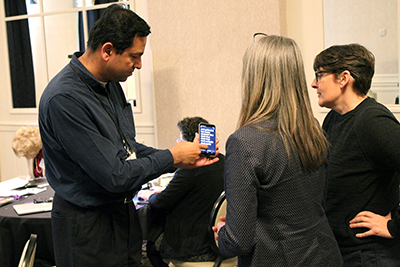
Friday, February 22
8:00–9:00 am
Breakfast and networking
9:00–9:30 am
Report out on dinner discussion
9:30–10:30 am
Accessible websites, videos, documents, and other materials
Gaby de Jongh, UW
10:45–12:15 pm
Short Presentations: Strategies Used in INCLUDES Projects and Other Broadening Participation Efforts
- Community Engagement for Cradle through Career STEM Learning – Joe Hastings & Kristin Leigh, Explora
- NSF Alliances for Students with Disabilities in STEM – Overtoun Jenda & Brittany McCoullough, Auburn University
- Introducing the Environmental Data Science Inclusion Network – Alycia Crail, Battelle
- Barriers to STEM Learning: Cognitive Loads in the Classroom – Ibrahim Dahlstrom-Hakki, TERC
- Providing Equitable Access to Computing Education in Mississippi – Sarah Lee, Mississippi State University
12:15–1:15 pm
Lunch and discussion
What are examples of collaborations that could be undertaken by stakeholder groups, specific conference participants, and/or other organizations that would support the project goal and objectives?
1:30–2:00 pm
Report out from lunch discussion
2:00–2:30 pm
Action plan: What changes do you plan to make that will lead to the INCLUDES Network being more accessible and welcoming to individuals with disabilities as an individual? As a project? Or in collaboration with others?
2:45–3:00 pm
Videos and other resources
Report out action plans, wrap up, what’s next, and evaluation
Presentation Summaries
Universal and Inclusive Design and Other Design Approaches that Lead to Inclusive Research and Practice
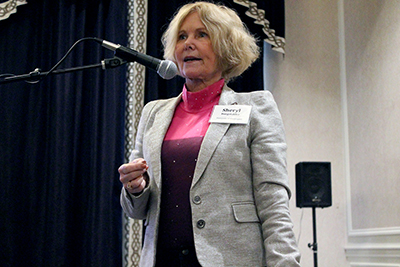
Sheryl Burgstahler, AccessINCLUDES
An inclusive environment lets in everyone who meets requirements with or without accommodations and makes sure everyone feels welcome and engaged. Ability exists on a continuum, where all individuals are more or less able to see, hear, walk, read print, communicate verbally, tune out distractions, learn, or manage their health. Most disabilities are invisible and many students and staff don’t report their disabilities to disability service offices. Regardless of where a person falls on this continuum and whether they request accommodations, we want to ensure that they have access to the classes we teach and resources we share. Students’ identities are also multi-faceted, which means we must consider an intersectional approach that acknowledges that some students are from more than one underrepresented group.
How society views disability has changed throughout the years. People with disabilities historically have been eliminated or excluded from society, segregated from the general population, aimed to be cured, rehabilitated, accommodated, and finally, accepted and included as they are. The modern approach has its roots in social justice and aims to allow all people to feel included, including those with disabilities.
In K-12 education, every child is offered a free and appropriate education in as integrated setting as possible. Once students reaches postsecondary education, they must meet the entrance requirements with or without reasonable accommodations. There are two approaches for making college and university campuses accessible: accommodations and universal design (UD). Accommodations are reactive and allow us to address the inaccessible features of a product or environment to make it more accessible to a particular individual who finds it inaccessible (e.g., captioning a video when a student with a hearing impairment requests it). Universal design is a proactive approach to create a product or environment accessible to the widest group possible (e.g., captioning all videos by default). A building with stairs at the entrance and a separate ramp for people with wheelchairs is technically accessible, while a building with a single entrance that everyone can use is universally designed.
Universal design doesn’t just help people with disabilities—sloped entrances help people moving carts, and captions help those learning English or in noisy environments, as just a few examples. Universally designed technology should have built in accessibility features and ensure compatibility with assistive technology.
UD of instruction is an attitude that values diversity, equity, and inclusion. It can be implemented incrementally, focuses on benefits to all students, promotes good teaching practice, does not lower academic standards, and minimizes the need for accommodations. UD can be applied to all aspects of instruction, including class climate, interactions, physical environments and products, delivery methods, information resources and technology, feedback, and assessment. To review an easy to use checklist, visit Equal Access: Universal Design of Instruction. For more tips, you can follow the 20 Tips for Teaching an Accessible Online Course at 20 Tips for Teaching an Accessible Online Course.
NSF INCLUDES and the Coordination Hub: Building a National Network to Advance Equity in STEM
Timothy Podkul, Stanford Research Institute (SRI) International
NSF INCLUDES (Inclusion across the Nation of Communities of Learners of Underrepresented Discoverers in Engineering and Science) is a national initiative designed to enhance US leadership in science, technology, engineering and mathematics (STEM) related discoveries and innovations by focusing on diversity, inclusion and broadening participation in STEM at scale. As of February 2019, the NSF INCLUDES National Network includes 70 Design and Development Launch Pilots from two cohorts, comprising 760 partner organizations in over 45 states; 16 conference awards; 5 alliances; and the NSF INCLUDES Coordination Hub, as well as NSF Resource Centers, Louis Stokes Alliances for Minority Participation awards, co-funded NSF INCLUDES projects and programs from no less than 13 different programs across the NSF, representatives from the philanthropic community and industry, and other federal agencies.
The five alliances include Computing Alliance of Hispanic-Serving Institutions (CAHSI), STEM Core Expansion, Inclusive Graduate Education Network (IGEN), Expanding the First2 STEM Success Network (FIRST2), and Aspire: National Alliance for Inclusive and Diverse STEM Faculty.
NSF INCLUDES projects focus on collaborative infrastructure:
- Vision: Engage the community in a shared vision
- Partnerships: Provide a platform for collaborative action
- Goals and Metrics: Allow for evidence-based decision-making
- Leadership and Communication: Increase communication and visibility
- Expansion, Sustainability, and Scale: Establish the capacity to grow and sustain
The Hub facilitates activities needed to build and maintain a strong NSF INCLUDES National Network, including communications, technical assistance and efforts aimed at increasing visibility. The Hub itself is a collaboration of multiple institutions. The Hub has five main aspects to its work:
- Broadening Participation and Collaborative Change
- Managing Communication and Networking
- Managing Network Assistance and Reinforcement
- Managing Visibility, Expansion, and Sustainability
- Goals, Metrics, and Evaluation
Our work is focused on changing the narrative of what success in STEM is. We aim to accomplish this through three fundamental actions:
- Fostering greater connectivity among broadening participation efforts to encourage collaboration, promote sustainability, and spark innovation
- Building alignment among broadening participation efforts to create shared identity, and define and share common outcomes broad enough for all to contribute
- Catalyzing collective action by leveraging local and regional activities, resulting in coordinated efforts taken to scale
The Hub offers multiple entry points and modes of engagement, including a website with resources and tools, an online community to share information and engage in discussion, social media and a newsletter, events, affinity groups, conferences, and shared measures for evaluation, measurement, and using data to inform decision-making. Our affinity groups support peer exchange and discussion as well as to create space for new affinity groups to form around common interests. Some current affinity groups include Indigenous STEM, Higher Education, Backbone Organizations, Evaluation, and Diverse Models of Collaboration.
We believe successful development of a shared measurement system involves capacity building for collecting, analyzing, interpreting and using data for decision making. We hope to take on these goals:
- Reach consensus on a core set of measures
- Inform continuous improvement and support organizational learning
- Enhance quality of data across the Network
- Enable NSF to demonstrate Network progress over time
The Hub also works to expand the NSF INCLUDES Network. We engage new members in the NSF INCLUDES Network’s shared vision and goals; connect with professional associations to offer opportunities for NSF INCLUDES Network members to share their work and provide thought leadership; and use a collective action mindset, bringing resources of the Network to bear on sector or institutional gaps in relevant systems. To connect with us, email us at nsfincludeshub@sri.com.
Accessible Websites, Videos, Documents, and Other Materials
Gaby de Jongh, University of Washington
We started this presentation with a demo of Microsoft Presentation Captions. To learn more about Microsoft Presentation Captions and try them out for yourself, visit this website.
There are four principles of accessibility: Technology must be perceivable, operable, understandable, and robust.
Accessibility is often misconstrued and misunderstood, not taught at all or seen as abstract or someone else’s responsibility, and people assume it takes too much time and planning. Accessibility should be considered throughout the creation of digital content.
Websites
HTML has a comprehensive set of semantic tags to allow the reader to understand the structure of the content and navigate throughout the text. Forms, math, and video can also be made accessible within HTML. We use WCAG 2.0 as our guidelines for creating accessible HTML. The biggest success criteria for A/AA levels include alt text on images, proper heading levels, labels on form fields, visible indication of keyboard focus, and not using color as the sole means of communicating information. Accessible Rich Internet Applications specifications communicate roles, states, and properties of interface elements for the benefit of assistive technology users. Adding these simple tags to sections of any web page will greatly improve the page navigability for screen reader users:
- role=”banner”
- role=”main”
- role=”navigation”
- role=”search”
- role=”complementary” (sidebar)
- role=”contentinfo” (footer)
- role=”application”
Documents
Microsoft Word uses Styles to indicate different tags and again allow the reader to understand the structure of the content and navigate throughout the text. Styles create a scaffolding to design both the visible and invisible structure. Use the accessibility checker to fix easy to find accessibility issues. Simple tables can be accessible, complex tables cannot be. Accessible math can be created via the MathType plug-in. Forms and Posters in Microsoft Word are completely inaccessible. Word does have the option to add alt text to images. For more information about describing images, see Effective Practices for Description of Science Content within Digital Talking Books.
PDF documents can come in one of three types: Scanned images, documents with text but no underlying structure, and tagged, well-structured documents. Tagged PDF is similar to HTML PDFs do support complex tables, but forms have minimal accessibility and they do not support accessible math. There is an accessibility checker in Adobe Acrobat, but it can sometimes be difficult to figure out how to fix the problems flagged. Accessible PDFs are only well supported in Windows. The standards for PDF accessibility is PDF/UA, and it is based off of WCAG 2.0. They require that:
- Content must be tagged in a logical reading order
- Tagged content must correctly represent the documents semantic structure
- Meaningful graphics must include alternative text descriptions
- Security settings must allow assistive technology access to the content
- Fonts must be embedded
Tagged PDFs were introduced in Acrobat 5.0 (2001), and they can only be created by specific authoring tools, including Microsoft Word. You can fix the accessibility of any PDF using Adobe Acrobat Pro.
Videos
Accessible videos include open and closed captions, audio description, and a transcript. Videos can be captioned through YouTube Caption editor (edit the automated version for accuracy), Amara (for foreign language translation), 3Play Media, Automatic Sync Technologies, Audio Eyes, and the Media Access Groups at the Western Great Blue Hill (WGBH) public radio station. When choosing how to deliver your video, it is important to consider options that are fully accessible. Whether you are selecting a media player plugin or module for your website or selecting a service to host your videos, the following questions should be answered about the available options:
- Does the media player support closed captions?
- Does the media player support audio description in a way that enables users to toggle the narration on and off?
- Can the media player’s buttons and controls be operated without a mouse?
- Are the media player’s buttons and controls properly labeled so they can be operated by a blind person using a screen reader?
- Is the media player fully functional, including all of its accessibility features, across platforms and in all major browsers?
Able Player, designed by Terrill Thompson at the University of Washington, is completely accessible and highly recommended.
Learning Management Systems
It is possible within most learning management systems (LMS’s) to have a fully accessible course; it is also possible within all LMS’s to have a fully inaccessible course. To ensure your content is accessible: Use headings, add alt text to images, add captions to videos (and audio descriptions as needed), upload accessible documents and HTML, and ask questions about accessibility about any tools used through your LMS.
Resources
- Website Resources
- Document Resources
- Video Resources
Short presentations: Disability and Accessibility in STEM Fields
Working Across Disciplines to Improve Digital Accessibility
Jonathan Lazar, University of Maryland, College Park
Almost accidentally, I ended up going back to school to study law and change my career to be more focused on how the law can change accessibility policies. There are three areas of law that you should be familiar with, as laid out below.
ADA and Web Accessibility
The Americans with Disabilities Act (ADA) was signed into law in 1990, before the advent of the internet. The Department of Justice (DOJ) stated publicly that the protections of the ADA apply to web sites of entities covered by Title II and Title III, under the effective communication requirement. The DOJ reaffirmed this in 2018. Courts have held since 2006 (National Federation of the Blind v. Target) that web sites of public accommodations are covered under the ADA. In 2017, the District Court dismissed Robles v. Domino’s Pizza LLC because “Plaintiff has failed to articulate why… compliance with a technical standard other than WCAG 2.0 [Web Content Accessibility Guidelines] does not fall within the range of permissible options afforded under the ADA.” In January 2019, this decision was reversed and remanded. The Ninth Circuit decision stated that “flexibility is a feature, not a bug, and certainly not a violation of due process” and “Our Constitution does not require that Congress or DOJ spell out exactly how Domino’s should fulfill this obligation.”
Copyright and Accessible Formats
The Chafee Amendment (Sec. 121 of the Copyright Act) states: “It is not an infringement of copyright for an authorized entity to reproduce or to distribute copies or phonorecords….if such copies or phonorecords are reproduced or distributed in specialized formats exclusively for use by blind or other persons with disabilities.” The 2nd Circuit Court of Appeals affirmed in 2014 that the fair use doctrine of copyright law allows the making of accessible digital copies of print books. The US just ratified and deposited the Marrakesh Treaty to facilitate access to published works to people with disabilities who cannot read physical text.
ADA and Testing Accommodations
ADA statute (§ 12189) states, “Any person that offers examinations or courses related to applications, licensing, certification, or credentialing for secondary or postsecondary education, professional, or trade purposes shall offer such examinations or courses in a place and manner accessible to persons with disabilities or offer alternative accessible arrangements for such individuals.” The ADA regulation (28 C.F.R. § 36.309(b)(1)(i)) helps to interpret this statute by stating, “The examination is selected and administered so as to best ensure that, when the examination is administered to an individual with a disability that impairs sensory, manual, or speaking skills, the examination results accurately reflect the individual’s aptitude or achievement level or whatever other factor the examination purports to measure, rather than reflecting the individual’s impaired sensory, manual, or speaking skills (except where those skills are the factors that the examination purports to measure).”
Equity by Design
Joan Freese, Twin Cities Public Broadcasting Service (PBS)
At Twin Cities PBS, we have two projects focused on STEM education: SciGirls Code and Hero Elementary.
SciGirls Code uses a national connected learning model to integrate computing in STEM learning with middle school girls. We implemented a nine-month curriculum on mobile apps, robotics, and e-textiles in 16 pilots sites with over 160 girls. We offered professional development for 32 STEM educators and role model training for female tech professionals. Our research is investigating the ways computational learning experiences impact the development of computational thinking as well as interest and attitudes toward computer science. Promising strategies used by SciGirls Code for addressing equity in learning technologies include uniting around a shared purpose; aligning home, school, and community; connecting to the interest and identities of minority children and youth; and targeting the needs of subgroups.
We partnered with the Pacer Center to work with students with disabilities and host three workshops; the Pacer Center helped us see how it was possible to work with students with disabilities and how to make sure all students felt included, especially in a group of students with disabilities instead of just one student with a disability trying to work with a group of students who don’t have disabilities.
Hero Elementary is a comprehensive media initiative that integrates television, digital media, outreach, and research. The project goal is to improve the school readiness in science and literacy of K-2 students living in poverty. We focus on low-income communities, English Language Learners, children with disabilities, and children from Latinx communities. Hero Elementary uses proven strategies to engage young learners in science, supporting early science learning with experiences that feature the following:
- Science connected to local places
- Culturally relevant pedagogy
- Real-world, hands-on learning
- Multimodal experiences, multiple representations
- Discussion and reflection
- Home and community partnerships
A collection of 31 “Playlists,” which include television episodes, digital or analog games, hands-on activities, the Science Power Notebook, learning analytics on a digital platform, educator assets, and children enrichment resources for parents. These playlists have adapted the Universal Design for Learning Guidelines Educator Checklist from the Center for Applied Special Technology (CAST), recommendations from a needs assessment with special education teachers and partners, and recommendations from Game accessibility guidelines.
Hero Elementary is partnering with Hope Haven, a public school for kids with disabilities in Jacksonville, FL, to work with their after-school program and see how the playlists and projects work with students. In the future, we hope to align universal design for learning with classroom strategies for informal educators.
Embedding Neurodivergent Software Design in a Computer Science Course
John Russo, Landmark College
Neurodiversity is a concept where neurological differences are to be recognized and respected as any other human variation. These differences can include those labeled with dyspraxia, dyslexia, attention deficit hyperactivity disorder, dyscalculia, autism spectrum, Tourette syndrome, and others. Cognitive abilities have a range. For example, people read and comprehend at different rates, recognize and understand more or less objects, can complete long tasks in a single session or need multiple sessions, become distracted more or less easily, and more. Autistic individuals may have difficulty interpreting the emotions of others, get lost easily, have challenges filtering out noise, and face confusion shifting between tasks. Individuals with attention deficits may have issues with memory limitations or choosing the correct word or sentence structure in addition to attentional bias. Software designers need to remember that one size doesn’t fit all when designing for neurodiverse users and should focus on functional impairments instead of looking at specific diagnostic profiles. As a general rule, they should design with cognitive load in mind. Abstract concepts, social and emotional cues, and symbols and icons can create problems in design.
In addition to teaching software design best practices, we can teach universal design principles into our courses, use individuals who are neurodivergent as subject matter experts, and find neurodivergent test users to evaluate the effectiveness of a design. In my future work, I hope to develop best practices for teaching neurodivergent software design as part of a computer science course. I plan to work with neurodivergent subject matter experts to test the validity of Web Content Accessibility Guidelines (WCAG) 2.0 guidelines and develop design team and testing team composition guidelines that could be disseminated to industry.
STEM Education and Career Exposure Software for Deaf and Reading-Challenged Students
Greg Monty, North Carolina A&T State University
Our name is EMERGE in STEM (Education for Minorities to Effectively Raise Graduation and Employment in STEM): Paving a K-12 Pathway to the STEM workforce through education and career exposure. We are part of the second cohort of INCLUDES Design and Development Launch Pilots. EMERGE in STEM has a galaxy of partners engaged in our project including partners from school districts, the State Department of Education, community organizations, colleges and universities, entrepreneurs, local commerce and industry, and our evaluation and assessment team. Additional partners will join over time. EMERGE in STEM is the go-to STEM center for Guilford County in North Carolina, maintaining a calendar of most STEM activities in the area. We are enlisting thousands of students in grades 4-12 to complete assessments before and after participation in STEM interventions.
Our Learning Blade software has missions that focus on 12 different contexts for STEM including energy production, robotics design, flu outbreak, and transportation congestion that relate to a variety of career clusters, with games and lessons involved with each context. Captions in the Learning Blade software provide access for students who are deaf or hard of hearing and students with reading-related disabilities. Many students with disabilities are using this software, and we are currently collecting data to determine how the software works for them. A report from Battelle Education found that overall, Learning Blade doubles the number of students interesting in engineering and science and leads to a 79% increase in students recognizing that “math is helpful when solving interesting problems,” 69% increase in students recognizing “what I learn in school will be useful later in life,” and 56% increase of students interested in taking advanced math classes.
Digital INaccessibility: Why Haven’t We Figured This Out Yet?
Nora Ryan, Iowa State University
The ADA, Sections 504 and 508 of the Rehabilitation Act, WCAG, Technology, Education and Copyright Harmonization (TEACH) Act, 21st Century Communications and Video Accessibility Act, and 21st Century Integrated Digital Experience Act (IDEA) all work to ensure access for people with disabilities in different contexts. Despite all this legislation, many digital resources are still inaccessible. There is a lack of clear federal regulations, little uniformity in assistive technology, insufficient promotion of inclusion and diversity, and an absence of education and awareness about accessibility.
We need more unambiguous, enforceable federal regulations, university policies that directly address digital accessibility, widespread education and awareness about accessibility, and certifications for both front-end designers and back-end developers. It’s 2019 and we’re still not even close to where we need to be when it comes to digital accessibility and equal access. Why haven’t we figured this out yet?
STEM Accessibility Alliance: Strengthening the National STEM Workforce through Accessible and Inclusive Strategic Alignment
Chris Atchison, University of Cincinnati
We’re not seeing disability included in broadening participation efforts as much as we should. The issue is not diversity but a lack of social justice (opportunity, access, inclusion, equity). As said by Robin Bell, President of the American Geophysical Union, “The success and advancement of Earth and space sciences depends on a diverse pool of researchers… We do better science when diverse voices are at the table.” People with disabilities are not entering postsecondary education and the STEM workforce at rates consistent with the total US population. One out of five Americans has a disability according to the US Census. More than one in three of American households surveyed had at least one member who identified as having a disability according to Nielsen data. More than one billion people have a disability worldwide (United Nations Enable).
Research and practice in access and inclusion has produced great outcomes, but not all efforts are aligned towards a common goal. Most activities are in reaction to needs that are years, and sometimes decades, overdue. We are still struggling to be proactive. Our projects spring up as a reaction to a problem independently from each other. PreK-12 educators (including the support staff and parents) are not fully aware of the accessible and inclusive opportunities in higher education and STEM careers their students with disabilities can successfully pursue. We are unaware of the needs of industry and the accessible careers that already do, or will exist, in the next ten years.
I am hoping to propose an INCLUDES Alliance that will
- utilize key findings from research that supports students with disabilities in workforce development to broaden the national talent in all STEM disciplines,
- support PreK-12 teachers and parents to encourage students to pursue STEM disciplines, and
- enlist corporate partners as mentors and visionaries for training the future of their workforce.
I envision the Alliance working broadly across sectors, STEM fields, and disability types, with the following objectives in mind:
- Have everyone at the table at the same time, including the very students, parents, and teachers we are trying to support.
- Work directly with corporate, government, non-profit partners to design pathways supporting PreK-12 students, parents, and teachers.
- Enable students with disabilities to graduate from secondary and post-secondary institutions with marketable skills that will make them strong candidates for STEM careers.
These are our collective impact goals:
- Establishing a cross-sector STEM access alliance in the tri-state area centered in Cincinnati.
- Enabling all project partners to identify sector-specific goals for increasing access and inclusion that align to the Alliance priorities.
- Creating a broader national STEM network building capacity of students with disabilities entering post-secondary education.
Research from Accenture found that companies that embrace best practices for employing and supporting people with disabilities in their workforce outperform their peers. Throughout this year, I will be working to identify partners, hold a conference, and develop a proposal for submission in the fall.
Short Presentations: Strategies Used in INCLUDES Projects and Other Broadening Participation Efforts
Community Engagement for Cradle through Career STEM Learning
Joe Hastings & Kristin Leigh, Explora
Explora is a 501c(3) science center and children’s museum, operating in a public-private partnership with the City of Albuquerque. We serve 325,000 people of all ages a year with STEM exhibits and programs. Explora serves as the backbone organization for STEM-New Mexico (NM), our state’s nationally-designated STEM Learning Ecosystem. One of Explora’s four core values is Community. We work hard to ensure Explora is useful, relevant, and an integral part of the community fabric. We utilize a Listen, Welcome, Co-create community engagement strategy, which involves formal community listening sessions, no-cost community partner memberships, and co-development of programs and initiatives. Explora’s other core values include Learning, Sustainability, and Generosity.
During our last strategic planning process, the leadership team decided we really needed to turn outward and focus in on our community’s aspirations and how Explora can contribute to community change. We used the Harwood Institute approach to ask the following questions: What kind of community do you want? What are the most important issues or concerns when it comes to the community? What do you think is keeping us from making the progress we want? What could we try that might make a difference? Who do we trust to take action?
You can’t decide where you are going until you listen to the entire community and hear their interests and concerns. We conducted listening sessions with a variety of local groups, and these aspirations were shared consistently among groups during these listening sessions:
- an inclusive, accessible community;
- a child-centered community;
- a community with abundant educational opportunities;
- a community with plentiful, high-quality early childhood education;
- a safe community;
- a community with less poverty and more jobs; and
- a community with well-planned neighborhoods.
We welcomed groups to Explora to utilize our space, provide access for families, and build partnerships. Through this, we got to know many of the disability groups in our community. One partnership we developed was with the New Mexico Autism Society (NMAS). With NMAS, we received funding to co-create and iterate on: sensory toolkits, sensory stories and maps, sensory-friendly hours, staff training, and summer camps for children on the autism spectrum. This partnership helped to normalize sensory needs. Signs about sensory resources led to new conversations. Sensory recovery kits were placed on the exhibit floor for potential stressful situations. Selling fidgets in the store increased awareness and access. We also developed sensory-friendly events that allowed for low attendance, a calmer environment, more judgment-free environments, sensory break rooms, additional signage, lower noise and light, and transitional items as kids leave the museum.
Explora also is part of an NSF INCLUDES project, called Math FACESS (Families and Communities Empowering Student Success in Mathematics) that aims to improve students’ attitudes, practices, and achievement in math; improve parents’ attitudes, practices, and confidence in math and increase their utilization of family math resources; improve data-sharing among partners related to math participation and achievement; and create pathways within the STEM-NM Ecosystem for family math learning. This project has four major components:
- Teachers at two pilot schools participate in professional development related to Math Talk and Listening (Hufferd-Ackles, et al. 2004; Hintz and Tyson, 2015);
- Parents at the pilot schools participate in parent workshops and community-based activities focused on supporting their children’s math achievement;
- Project partners implement community-based family activities organized around a theme of 12 Months of Math (12MoM); and
- Ecosystem partners study what worked and what didn’t, in order to identify best practices that can be shared with system leaders to scale effective practices and increase impact.
NSF Alliances for Students with Disabilities in STEM
Overtoun Jenda & Brittany McCoullough, Auburn University
Our first alliance for students with disabilities in STEM started in 2009 as part of NSF’s Research in Disabilities Education program (RDE). The Alabama Alliance for Students with Disabilities in STEM focused on increasing the number of degrees and overall success being achieved by students with disabilities at five institutions in East-Central Alabama. In 2016 we were awarded funding for our current NSF INCLUDES Pilot Project, South East Alliance for Persons with Disabilities in STEM, which brings together 21 institutions throughout the southeastern US. In this project, some institutions hosted pilot sites, while others hosted workshops or training opportunities. We are hoping to expand this project to be a national program in an upcoming INCLUDES proposal titled The Alliance for Persons with Disabilities in STEM that will involve 37 institutions from across the country.
In our NSF projects, we have successfully utilized a variety of interventions: peer and faculty mentoring, small student cluster groups, monthly group meetings, research internships and presentations, and annual conferences. We also hosted two academies funded by government partnerships, one for blind/visually impaired high school students, and one for deaf/hard-of-hearing high school students. We have had over 250 students participate to date. Our participants have received 121 bachelor’s degrees, 15 masters, and 2 doctoral degrees. Graduate school entrance rates were higher than the overall student population. Participants had increased self-efficacy and persistence in STEM, increased self-advocacy behaviors, and successful creation of a supportive academic and social network.
Visit cws.auburn.edu/apspi/pm/includes to learn more or partner on this project.
Introducing the Environmental Data Science Inclusion Network
Alycia Crall, Battelle
There has been a growth of large ecological data sets and environmental synthesis projects. Analyses of these datasets and policies driven by those analyses may have profound environmental and societal implications. We want to bring together the practitioners, researchers, educators, evaluators and employers to work towards a more inclusive field to ensure the field reflects the diversity of the communities it serves. Our NSF INCLUDES conference Bringing Conversations on Diversity, Equity and Inclusion in Data Science to the Environmental Sciences will begin this conversation.
Our conference will feature an opening panel to discuss inclusion, with Gina Helfrich from the Numerical Foundation for Open Code and Useable Science (NumFOCUS), Cedric Chambers from Jobs for Underrepresented and Minority Professionals (JUMP) Recruits, Kaitlin Stack Whitney from the National Technical Institute for the Deaf, Clyde Cristman from the Virginia Department of Conservation and Recreation, and Dennis Dye from the Bureau of Indian Education. Our plenary speakers include Carolyn Finney, who will speak about environmental and social justice considerations in the world of big data; Carlos Castillo-Chavez, who will speak about the application of mathematics to environmental science issues and recruitment and retention of minorities in the data sciences; Melvin Hall, who will speak about evaluation of data science programs and culturally responsive evaluation; Drew Hasley, who will speak about data visualization for students with visual impairments; Melinda Laituri, who will speak about spatial justice and data ethics and analysis of the interactions between space and society to understand social injustices; Marco Hatch, who will speak about the integration of traditional ecological knowledge and recruitment and retention of indigenous students; and Whitney Tome, who will speak about increasing racial diversity within large environmental non-profits, foundations, and federal government agencies. There will also be posters and lightning talks to increase awareness of relevant initiatives and conference attendees will identify and prioritize topics for breakout discussion sessions. Learn more at edsin.qubeshub.org.
The National Science Foundation’s National Ecological Observatory Network (NEON) project is a continental-scale ecological observation facility operated by Battelle. NEON provides the following:
- Free and open data on the drivers of and responses to ecological change
- A standardized and reliable framework for research and experiments
- Data interoperability for integration with other national and international network science projects
We host 81 field sites across the country, providing over 170 data products. Standardized data collection methods are used across all sites using automated instruments, observational sampling, and airborne remote sampling. Via our data portal, you can download data, view the data product catalog, and read protocols. We also offer self-paced tutorials, teaching modules, data skills workshops, science videos, research internships, and seasonal fieldwork. We are working to increase accessibility of NEON resources by captioning videos on YouTube, adding alt text to images and figures in data skills tutorials, requesting information about the accessibility needs of workshop participants, checking the accessibility of our documentation, and recommending resources to make data and data skills trainings more accessible.
Barriers to STEM Learning: Cognitive Loads in the Classroom
Ibrahim Dahlstrom-Hakki, Technical Education Reasearch Centers (TERC)
It’s important to understand cognitive load. The processing capacity of our working memory is limited. A limited number of items can be held in working memory at any one point. Working memory can act as both a gateway to information processing and knowledge acquisition and as a bottleneck in acquiring and expressing knowledge. There are both intrinsic and extraneous processing loads when we learn. An extraneous load is part of a learning task that is not integral to the learning goal (i.e., spelling in a critical thought essay or reading in algebra word problem). An intrinsic load is the core elements of the learning task (i.e., the analysis in a critical thinking essay or algebraic reasoning in an algebra word problem). Learning is efficient when cognitive load doesn’t exceed working memory capacity. This happens when extraneous loads are low and the intrinsic loads are appropriate to the learner’s ability level. Learning is slowed or stops when cognitive load exceeds working memory capacity. This may happen if the intrinsic load is beyond a learner’s ability level or when extraneous loads are high.
Factors that limit available working memory include weaknesses in memory, attention, or executive function; language deficits; poorly automatized skills; and anxiety and other affective issues. Automatization of skills, addressing confidence and other affective issues, and effective strategy use can reduce extraneous cognitive load and free up working memory.
- Common sources of struggle can come from
- Poor or confusing formatting – 3a + 23 = 2a – 7 is easier to solve than IVa – XIX = IIa + VII.
- Attention load simulation – In a geometry problem, it’s easier to solve a problem when the necessary information is embedded in the diagram.
- language processing, and
- anxiety.
Providing Equitable Access to Computing Education in Mississippi
Sarah Lee, Mississippi State University
In 2016, the Mississippi Alliance for Women in Computing received INCLUDES funding. Mississippi has the lowest median wages in the US and lowest rates of STEM employment, with women and people of color largely underrepresented in computing professions. Computer scientists in the southern US are underrepresented compared to the rest of the nation. Our Alliance illuminates computing pathways for women by attracting white women and women of color into computing, improving the retention rates of women in computing majors, and helping women transition into the computing workforce. With a variety of partners, we have offered summer programs for K-12 students in computer science and cybersecurity outreach; extracurricular activities, mentoring, and tutoring for college students; Attract-Inspire-Mentor PK-12 teacher professional development, and coding academies.
There are Mississippi Coding Academies in both Jackson and Golden State. They are tuition-free, 11 months opportunities with an employer-driven curriculum and a highly selective recruitment process. Students learn full-stack coding, soft skills, and have a direct connection with employers. The goal was to create opportunities, respond to a growing employment need for tech-skilled workforce, boost the innovation ecosystem for the state, and attract industry with a technology-trained workforce supply.
One of our partners is Academics, Campus Life, Community Involvement, Employment Opportunites, Socialization, and Self-Awareness (ACCESS) at Mississippi State University, a 4-year, comprehensive transition program designed as an inclusive post-secondary experience for students with developmental and intellectual disabilities. ACCESS students enroll in the University, participate fully in all aspects of college life, graduate from the program, and transition to their chosen employment and living situations, having become proficient in self-advocacy and self-determination. We have built a partnership between our Coding Academies and students in the ACCESS program. We want to open up pathways for women and people of color, but also for people with disabilities and other minority groups. We are looking to expand our Alliance throughout the Southern US in the future.
Panel Discussion Summary: Experiences of People with Disabilities in STEM Fields
Panelists: Nils Hakansson (Wichita State University), Raja Kushalnagar (Gallaudet University), Marta Larson (Michigan After-School Partnership), and Vinod Namboodiri (Wichita State University)
Moderator: Brianna Blaser, UW
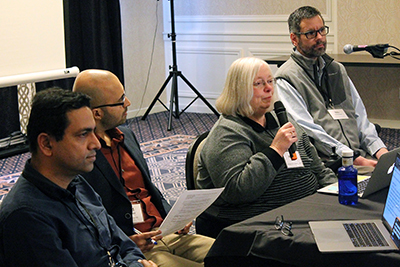
As an educator and person with a disability, what do you wish educational researchers knew about people with disabilities or their experiences?
- Coming from a smaller school, people can often say they don’t have the resources available for accessibility. Cost and time allocation comes up much more often. I wish educators or organizations could support this issue and provide resources for providing accommodations. Organizations often see people with disabilities as an expensive cost allocation.
- All institutions should include people with disabilities on their advisory board. People with disabilities are highly varied. Even two people with the same disability may need different accommodations. If there are more voices of people with disabilities, your organization or institution will be more universally designed.
- Accommodations should be kept as streamlined as possible. I don’t want to be identified as different, and I don’t want to have to search around to find accessibility.
- Faculty can often see accommodations and accessibility as controlling what they can do and how they teach. However, faculty should see accessibility as a partnership that allows all people to be educated. Instead of punitive practices, there should be encouragement and understanding of inclusion.
- People have often labeled me a specific way and provided accommodations only within that label. People with disabilities need to be included in the accommodation discussion instead of exterior to it.
- If departments have to provide funding for accommodations, that can be difficult. If funding comes from a central budget of the university, it would be a lot easier for technology to be purchased and accommodations provided.
What things would you want as faculty that you used to have as a student?
- Students are often provided with resources and accommodations, whereas staff and faculty often have to go through other venues or don’t have the same options. Sometimes staff and faculty aren’t sure how to get accommodations.
- Staff and faculty usually go through HR for accommodations, which can work at a different speed than student offices. Faculty and staff often come after students in the case of access. Even more so, staff and faculty accommodations are not covered by the same budgets that students’ accommodations are covered.
- Since I am not in a single institution, I have to be my own support group. I have to provide my own accommodations. I often feel like I don’t have a system and when I go to new locations, I have to have the same battles and same issues repeatedly and fight for my own accommodations. There should be more knowledge and shared resources to all institutions and venues.
What would you want your colleagues and peers to know about how best to support you as a person with a disability?
- I ask students to ask me questions and feel comfortable talking about my disability, as well as the fact that I may be asking for help in relation to my disability. I am proactive about open communication.
- Find a way to interact with me that isn’t about my disability. For example, people need to learn how to walk slower, speak up, listen better, and find ways to interact with others that helps the person with a disability feel included.
Discussion Summary
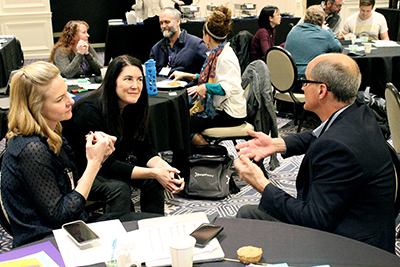
What can we do to increase the representation of people with disabilities in INCLUDES projects? Why haven’t more INCLUDES projects considered disability?
- People with disabilities are often seen as separate from other minorities. Alliances should take an intersectional approach to considering identity. Disability is often not included in the diversity conversation.
- Disability data should be collected. NSF and other institutions can provide advice for collecting data on disability.
- People often think there is stigma in disabilities and may not want to create organizations around disabilities because of this.
- People feel like they don’t want to do more work for only 10-15% of the population or claim it is too hard to find participants for these projects.
- People need people with disabilities on their teams. If people with disabilities aren’t included in leadership, then people with disabilities are more likely to be forgotten.
- There is a lack of expertise in disability and accessibility in many research teams that could be addressed with more courses, training materials, and webinars on the subjects.
- There needs to be more transparency in the proposal selection process. It would be helpful to know how many proposals addressed disability and how many awards were given to projects that address disability.
- All current projects should be evaluated for how they work with different underrepresented groups and how accessible they are, and then tools should be given to make them more inclusive.
- Grant reviewers often don’t understand the needs and cost allocations in relation to disability. Grant reviewers should receive a training on disability and there should be a checkbox about accessibility for the proposal selection rubric.
- Projects should encourage self-identification and create a welcoming environment by saying they especially include women, minorities, and people with disabilities.
- Many STEM programs find the physical requirements to be harder for people with disabilities and therefore exclude them on the basis of expectations (instead of thinking about accommodations or roles that people can take on in a project).
- More resources should be offered to all projects on how to address disability-related issues.
- There is a lot of stigma around disability, especially in STEM and education. People are less likely to self-identify, therefore leading projects to believe there aren’t enough people with disabilities interested.
What resources would be useful to the INCLUDES community in helping them (1) better address disability-related issues, (2) make activities more welcoming and accessible, and (3) develop collaborations that lead to future innovative projects and resources that are inclusive of individuals with disabilities?
- Resources to help those that aren’t focused on disability, but should be considering disability in their own work. Include disability as a social justice issue, a STEM issue, a cultural issue, etc. Disability needs to be included in organizations that focus on all of these topics (e.g., Peggy Macintosh’s work that focuses around privilege).
- More concrete statements of need that better describe how people with disabilities are excluded and underrepresented in STEM.
- More resources that define jargon and theories and help introduce people into the STEM world who are from organizations that are about inclusion but not necessarily STEM focused.
- More role models with disabilities and more profiles of people with disabilities who have been successful in STEM.
- The Disabled List will connect people with disabilities with design studios so people with disabilities can give their expertise to these studios.
- Creating a resource or checklist for conference and presentation accessibility.
- More lists of organizations that provide support and resources around accessibility and universal design, or a national center on disability that could provide support to all projects.
- Sharing more on social media about disability and accessibility.
- Better search functionality on NSF to see other broadening participation and INCLUDES projects.
- Invite more people with disabilities and more people who can benefit from our expertise to our conferences or host more events where we invite others from the community to attend and learn more.
- More internship support for students with disabilities.
- Question how we are translating theory (such as Tinto’s Theory of Integration) into practice and how we can find more concrete linkages between research and practice.
- Create annotated bibliography related to the participation of people with disabilities in STEM.
- The INCLUDES Hub should share more resources by creating a database of organizations and facilitating networking between them.
- More data needs to be collected and shared on disability, accessibility, how privilege affects non-minorities, etc. White papers could be written to share this information and data.
- Use process-oriented projects to improve processes over individual outcomes.
What are barriers and possible solutions individuals with disabilities might encounter within INCLUDES or other STEM research, instruction, and projects?
- Disability is a wide range of differences and needs compared to other groups included in broadening participation efforts.
- Barriers can include physical needs such as transportation, buildings, and the environmental as well as stigma and attitudes around disability.
- Cost and time can be seen as barriers in working with people with disabilities.
- It is often societally acceptable to not make things accessible, and there is a lack of knowledge around why accessibility is important.
- Research and STEM events need to be made welcoming to people with disabilities—it can be hard to be the first person to join, especially if they don’t feel welcome.
- Traditional methods of teaching often exclude the broad spectrum of student ability.
- Instructors are often have a specific mindset of what a student should look like.
- There’s a perception that there are limited role models in STEM for people with disabilities.
- Look at the Institute for Equitable Evaluation for best practices and encourage participatory design.
What are examples of collaborations that could be undertaken by stakeholder groups, specific conference participants, and/or other organizations that would support the project goal and objectives?
- Currently funded projects should help fund initiatives and give expertise to others. For example, we can come give presentations or give stipends to students with disabilities to become more involved with their community or to hire someone to remediate documents.
- We need to partner with industry and widen their lens on disability and how hiring more people with disabilities and focusing on accessibility can help their companies.
- We can share more resources among broadening participation groups and use the INCLUDES Hub to disseminate those resources and partnerships.
- DO-IT and similar organizations can share resources to begin addressing accessibility within the INCLUDES network.
- Conferences should have an INCLUDES track that helps bring more people into the community about inclusion and accessibility.
- More people in the disability community and with accessibility expertise should be peer reviewers for NSF grant panels and submit INCLUDES proposals.
- All of these communities and people interested in accessibility should come and join the INCLUDES Hub and Community of Practice to help create a movement.
- We need more funding to help focus the community and keep everyone engaged in the accessibility movement.
- A disability-specific INCLUDES Alliance is one goal, but pushing for the meaningful and authentic inclusion of disabilities in other Alliances is just as important.
- Stakeholders and partners should identify areas of need not commonly addressed in most projects, such as financial burden, parent engagement, student voice, etc.
What changes do you plan to make that will lead to the INCLUDES Network being more accessible and welcoming to individuals with disabilities as an individual? As a project? Or in collaboration with others?
- Provide a list of resources available to individuals working with disabilities to conference attendees.
- Give a presentation to program staff to increase awareness of existing tools and resources.
- Partner with other attendees to identify opportunities to collaborate to expand resources available.
- Make our project website, resources, application, and videos more accessible and ensure that our research captures available data on disability.
- Have the INCLUDES Hub convene our community of practice and host more resources on accessibility.
- Continue to collaborate with other teams to cross-pollinate ideas on accessible computing and education access in general.
- Review the INCLUDES portfolio; engage relevant projects as targets for dissemination and knowledge translation of research findings pertaining to students with disabilities and accessibility.
- Volunteer as a reviewer for NSF.
- Act as a broker in putting experts in disabilities supports in contact with people who want to do more in their work but don’t have the tools or resources to do so.
- Collaborate across campus to bring more knowledge of accessibility to faculty, and get more faculty involved in accessibility.
- Add disability demographic questions to future surveys.
- Create more effective channels of communications.
CBI Participants
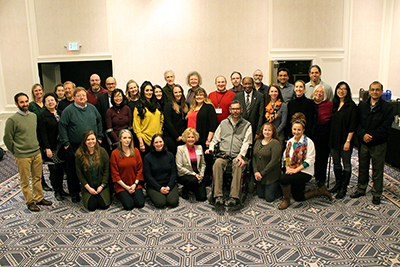
Participants represented those from INCLUDES projects working to bring disability into greater focus throughout the INCLUDES program.
Chris Atchison
Associate Professor
University of Cincinnati
christopher.atchison@uc.edu
Brianna Blaser
Program Coordinator/Counselor, AccessINCLUDES
University of Washington
blaser@uw.edu
Scott Bellman
Program Manager, DO-IT Center
University of Washington
smf23@uw.edu
Sheryl Burgstahler
Director, Accessible Technology Services, DO-IT Center
University of Washington
sherylb@uw.edu
Carrie Bruce
Senior Research Scientist
Georgia Institute of Technology
carrie.bruce@gatech.edu
Isabel Carrera Zamanillo
DEI Program Operations Specialist
University of Washington
micz@uw.edu
Alycia Crall
Science Education and Evaluator
Battelle, NEON Project
acrall@battelleecology.org
Lyla Crawford
Program Coordinator/Internal Evaluator
DO-IT, University of Washington
lylac@uw.edu
Ibrahim Dahlstrom-Hakki
Senior Research Scientist
TERC
idahlstromhakki@terc.edu
Gaby de Jongh
IT Accessibility Specialist
University of Washington
gabyd@uw.edu
Stephanie Del Giorgio
Grant and Project Support Coordinator
Northern Arizona University
stephanie.delgiorgio@nau.edu
Joan Freese
Director, Educational & Digital Media
Twin Cities PBS
jfreese@tpt.org
Nils Hakansson
Associate Professor
Wichita State University
nils.hakansson@wichita.edu
Joe Hastings
Executive Director
Explora
jhastings@explora.us
Nicole Herrera
Academic Success Specialist
Arizona State University
nherrer9@asu.edu
Anh Hua
University of Washington
ahua011@gmail.com
Overtoun M Jenda
Assistant Provost and Professor
Auburn University
jendaov@auburn.edu
Leslie Kollar
Graduate Student
University of Florida
kollarlm@ufl.edu
Raja Kushalnagar
Director, Information Technology Program
Gallaudet University
raja.kushalnagar@gallaudet.edu
Marta Larson
STEM Consultant
Michigan After-School Partnership
mlarson@umich.edu
Jonathan Lazar
Professor, iSchool, Associate Director, Trace Center, and core faculty
Human-Computer Interaction Lab (HCIL)
University of Maryland
jlazar@umd.edu
Elizabeth Woolner
Operations Specialist
University of Washington
eol@uw.edu
Sarah Lee
Assistant Department Head & Associate Clinical Professor
Mississippi State University
sblee@cse.msstate.edu
Kristin Leigh
Deputy Director & Director of Community Engagement
Explora
kleigh@explora.us
Brittany McCullough
Program Analyst
Auburn University
bnw0005@auburn.edu
Sarah Miller
Assistant Dean
University of Colorado Boulder
sarah.m.miller@colorado.edu
Steven Moats
Director-Student Accessibility Services
Iowa State University
smoats@iastate.edu
Greg Monty
Director, Center for Energy Research and Technology (CERT)
North Carolina A&T State University
ghmonty@ncat.edu
Nathan W. Moon
Senior Research Scientist
Georgia Institute of Technology
nathan.moon@gatech.edu
Vinod Namboodiri
Associate Professor
Wichita State University
vinod.namboodiri@wichita.edu
Elissa Olsen
Professor
Rochester Institute of Technology (RIT) / National Technical Institute for the Deaf
elissa.olsen@rit.edu
Patti Ordóñez
Associate Professor
University of Puerto Rico Río Piedras
pattiordonez@gmail.com
Alexis Petri
Associate Research Professor
University of Missouri-Kansas City
petria@umkc.edu
Tim Podkul
Director, NSF INCLUDES Coordination Hub
SRI International
timothy.podkul@sri.com
Mohammed A. Qazi
Professor of Mathematics and Assistant Dean for Development and Outreach
Tuskegee University
mqazi@tuskegee.edu
John Russo
Associate Professor
Landmark College
johnrusso@landmark.edu
Nora Ryan
Inclusion Services Coordinator
Iowa State University
nora@iastate.edu
Joerg Schlatterer
Director, American Chemical Society (ACS)Bridge Program
j_schlatterer@acs.org
Joetta Sieglock
Adaptive Technology Retention Specialist
Eastern Washington University
jsieglock@ewu.edu
Kelsey Smith
Programs Coordinator
The Discovery Center
ksmith@explorethedc.org
Gay Stewart
Professor
West Virginia University
gbstewart@mail.wvu.edu
Bob Stodden
Professor/PI
University of Hawaii at Manoa
stodden@hawaii.edu
Alyssa Taylor
Senior Lecturer
University of Washington
actaylor@uw.edu
Jennifer Yu
Sr. Principal Research Scientist
SRI International
jennifer.yu@sri.com
Communities of Practice
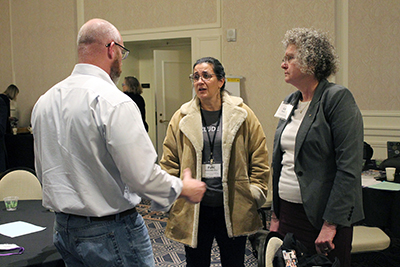
The AccessINCLUDES Community of Practice discusses ways to increase the engagement of disability in the INCLUDES community. Send a request to join to doit@uw.edu.
Other communities of practice hosted by the DO-IT Center can be found on the Communities of Practice page.
The NSF INCLUDES Coordination Hub (Award HRD-1818635) is funded to lead and serve the NSF INCLUDES National Network. The Hub works to
- Strengthen a common vision among those working to improve equity and inclusion in STEM;
- Broker connections among Network members—and across education, industry, government, and philanthropy groups—through an online community, webinars, convenings, and related events;
- Measure progress and impact across the Network;
- Promote the success of Network members, and elevate expertise by developing and sharing events, tools, and resources to support learning, action, and sustainability; and
- Advance the field by communicating discoveries, facilitating opportunities for broad engagement, and catalyzing action to improve STEM inclusion and equity
Resources
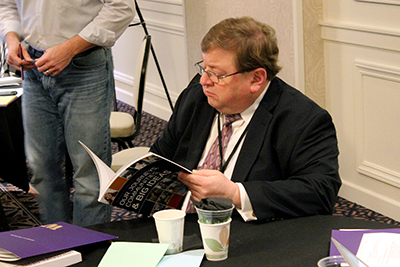
The DO-IT website contains
- information about DO-IT projects
- evidence-based practices that support project goals and objectives
- resources for students with disabilities
- educational materials for teachers and administration
DO-IT and AccessINCLUDES maintain a searchable database of frequently asked questions, case studies, and promising practices related to how educators and employers can fully include students with disabilities. The Knowledge Base is an excellent resource for ideas that can be implemented in programs in order to better serve students with disabilities. In particular, the promising practices articles serve to spread the word about practices that show evidence of improving the participation of people with disabilities in postsecondary education.
Examples of Knowledge Base questions include the following:
- Are electronic whiteboards accessible to people with disabilities?
- Are there computer keyboards designed to be used with only one hand?
- Are touch screens accessible?
- Do postsecondary institutions have to provide assistive technology (for example, screen enlargement or voice recognition software) to students with disabilities who enroll in distance learning courses?
- Does a postsecondary institution have to provide specific hardware or software (known as assistive technology) that an individual with a disability requests so that they can access information technology used on campus?
- Are funds available specifically for captioning?
- Are there any web-based tutorials on web accessibility?
Individuals and organizations are encouraged to propose questions and answers, case studies, and promising practices for the Knowledge Base. Contributions and suggestions can be sent to doit@uw.edu.
To learn more about disability, accessibility, and universal design in STEM review the following websites and brochures:
- More information on universal design in education can be found at the Center for Universal Design in Education.
- 20 Tips for Teaching an Accessible Online Course.
- Guidelines and resources for creating video and multimedia products that are accessible to people with sensory impairments.
- A list of thirty different web accessibility tips, and how to implement those tips, can be found at 30 Web Accessibility Tips.
- The University of Washington’s hub for information on accessible technology, featuring how to create and develop accessible documents, videos, and websites, can be found at Accessible Technology.
Acknowledgments
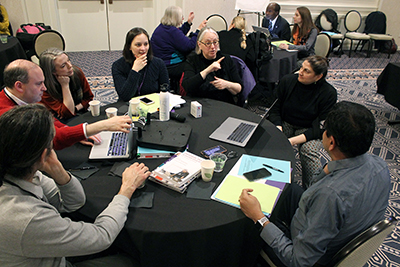
AccessINCLUDES capacity building activities are funded by National Science Foundation under Grant # HRD-1834924. Any opinions, findings, and conclusions or recommendations expressed in this material are those of the CBI presenters, attendees, and publication authors and do not necessarily reflect the views of the National Science Foundation or University of Washington.
DO-IT
University of Washington Box 354842
Seattle, WA 98195-4842
doit@uw.edu
www.uw.edu/doit
206-685-DOIT (3648) (voice/TTY)
888-972-DOIT (3648) (toll free voice/TTY)
206-221-4171 (FAX)
509-328-9331 (voice/TTY) Spokane
Founder and Director: Sheryl Burgstahler, Ph.D.
Project Coordinator: Brianna Blaser
Copyright 2019 University of Washington. Permission is granted to copy this publication for educational, noncommercial purposes, provided the source is acknowledged.